Get free scan and check if your device is infected.
Remove it nowTo use full-featured product, you have to purchase a license for Combo Cleaner. Seven days free trial available. Combo Cleaner is owned and operated by RCS LT, the parent company of PCRisk.com.
What is Words malware?
Words is the name of a malicious program, which our research team found while inspecting fake "cracked" software download sites. The Words malware is capable of force-opening untrustworthy and hazardous websites, and it might have other harmful abilities as well.
It is noteworthy that this program attempts to avoid user detection by using the Microsoft Word icon and the process name "words" on the Task Manager.
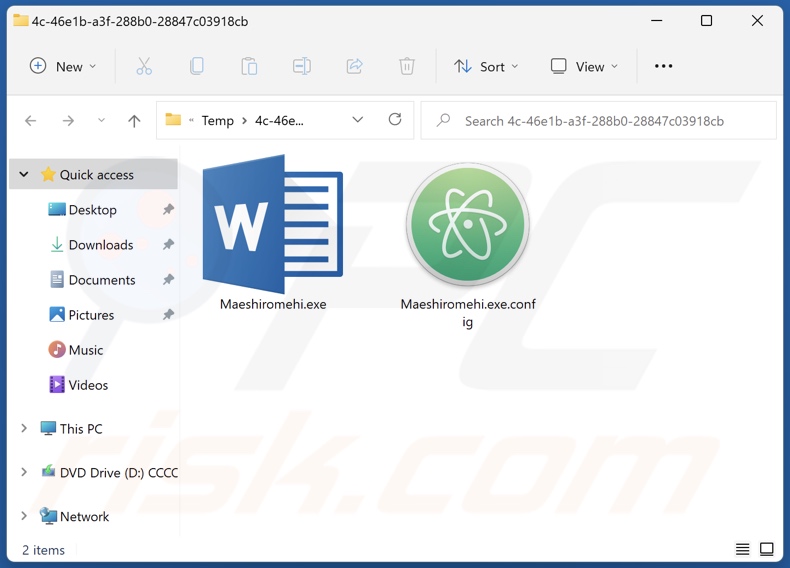
Words malware overview
After installing Words on our test machine, we learned that it force-opens various webpages. Typically, software with such capabilities causes redirects to sites promoting questionable content (gambling, pornography, adult-dating, etc.), online scams (phishing, fake: virus and outdated software alerts, lotteries, reward programs, giveaways, etc.), unwanted and hazardous applications, and even malware.
It is not unlikely for Words to have additional malicious functionalities. Malware is often multifunctional, and the developers commonly add features to it.
The most common functions include: installing other malware (chain infections), spying (e.g., keylogging, recording audio and video via microphones and webcams, etc.), encrypting data and/or locking the device's screen (ransomware), abusing system resources to generate cryptocurrency (cryptominers), exfiltrating files and data from systems and installed apps, replacing information copied into the clipboard, and so forth.
Furthermore, the installer that carried Words was also bundled with other unwanted software. Therefore, users may also experience adware, browser hijacker, and other infections.
In summary, Words infections may lead to severe privacy issues, financial losses, and even identity theft. If you suspect that Words has infiltrated your system, we advise using an anti-virus to remove it without delay.
| Name | Words virus |
| Threat Type | Malware, Unwanted redirects, Unwanted ads, Pop-up Virus |
| Detection Names (malicious installer) | Avast (Win32:Trojan-gen), Combo Cleaner (Dropped:Trojan.GenericKD.49007540), ESET-NOD32 (Multiple Detections), Kaspersky (Trojan.Win32.Agent.xapfll), Microsoft (Trojan:MSIL/RedLineStealer.AH!MTB), Full List Of Detections (VirusTotal) |
| Detection Names (Words) | Avast (Win32:AdwareX-gen [Adw]), Combo Cleaner (Gen:Variant.Bulz.543135), ESET-NOD32 (A Variant Of MSIL/Adware.CsdiMonetize.B), Kaspersky (Trojan-Downloader.MSIL.CSDI.gen), Microsoft (Trojan:Win32/Conteban.A!ml), Full List Of Detections (VirusTotal) |
| Rogue Process Name | words |
| Symptoms | Unprompted redirects to suspicious and potentially malicious sites. |
| Distribution Methods | 'Cracked' software installers, infected email attachments, malicious online advertisements, social engineering. |
| Damage | Decreased computer performance, serious privacy issues, possible additional malware infections. |
| Malware Removal (Windows) |
To eliminate possible malware infections, scan your computer with legitimate antivirus software. Our security researchers recommend using Combo Cleaner. Download Combo CleanerTo use full-featured product, you have to purchase a license for Combo Cleaner. 7 days free trial available. Combo Cleaner is owned and operated by RCS LT, the parent company of PCRisk.com. |
Malware examples
We have extensive experience researching malware infections - we've analyzed thousands of malicious programs. Dllhost.exe malware, 3Ex2BJT2aiqDJKPAFeuWMbB4T6MhML384p, Burmilla Stealer - are merely a few examples of our newest finds.
Malware can have a broad range of functionalities, which can be in different combinations. However, regardless of how malicious software operates - its presence on a system endangers device/user safety. Therefore, all threats must be eliminated immediately upon detection.
How did Words install on my computer?
We obtained Words from a fake "cracked" software download website. However, this program is likely spread using other methods as well.
The most popular malware proliferation techniques include: malicious attachments and links in spam emails/messages, drive-by (stealthy and deceptive) downloads, untrustworthy download channels (e.g., freeware and third-party sites, Peer-to-Peer sharing networks, etc.), illegal program activation ("cracking") tools, online scams, and fake updates.
How to avoid installation of malware?
We highly recommend downloading only from official and verified sources. Furthermore, all programs must be activated and updated with tools provided by legitimate developers.
We advise exercising caution with incoming mail. The attachments and links found in suspect/irrelevant emails and messages - must not be opened, as that can result in a malware infection.
It is crucial to have a reputable anti-virus installed and updated. Security software must be used to run regular system scans and to remove detected/potential threats. If your computer is already infected with Words, we recommend running a scan with Combo Cleaner Antivirus for Windows to automatically eliminate this malware.
Screenshot of Words malware's installation setup:
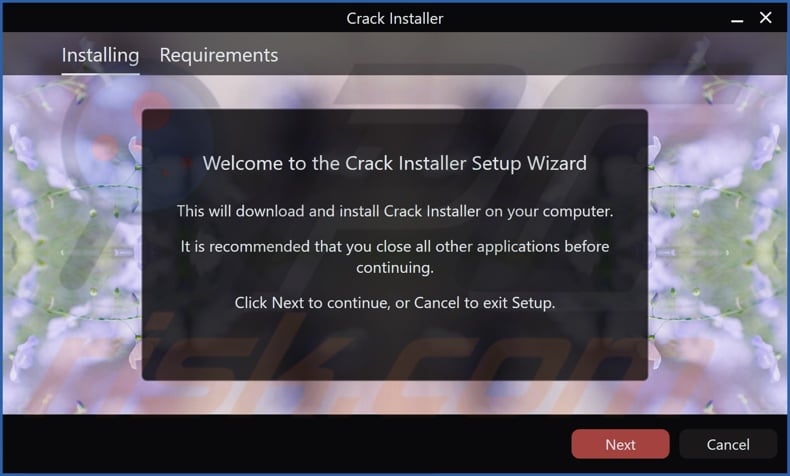
Screenshot of Words malware's process on Windows Task Manager ("words" process name):
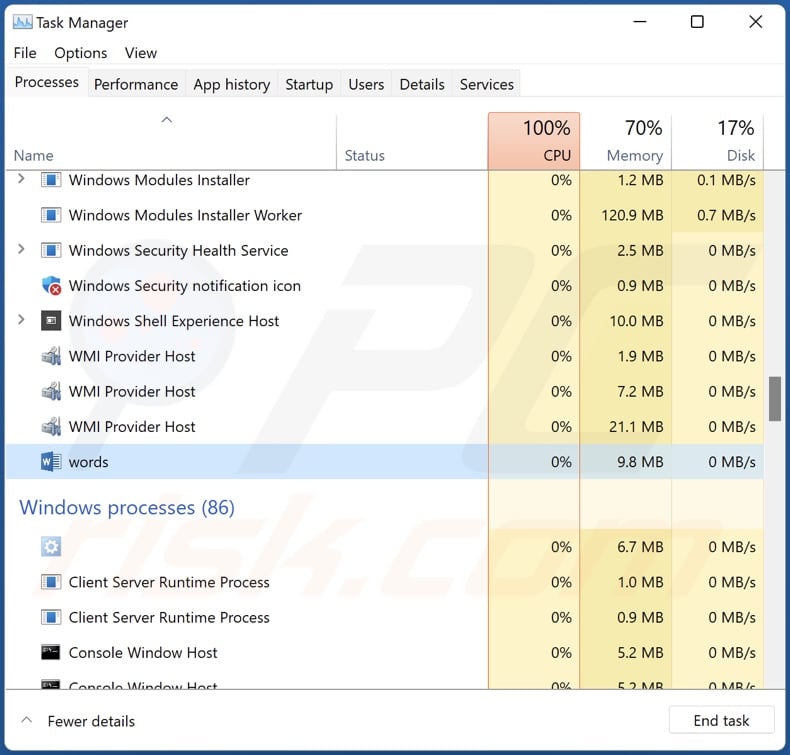
Screenshot of the fake "cracked" software download website used to promote Words malware:
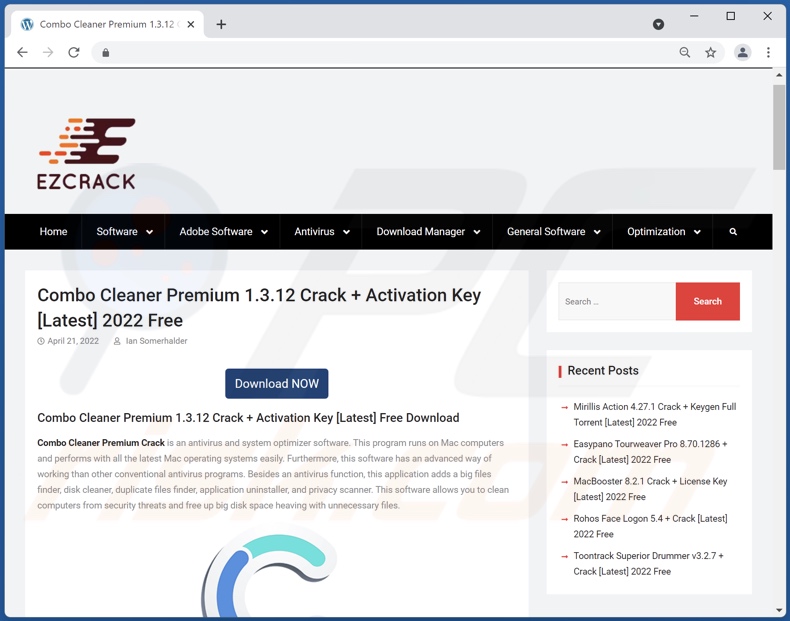
Instant automatic malware removal:
Manual threat removal might be a lengthy and complicated process that requires advanced IT skills. Combo Cleaner is a professional automatic malware removal tool that is recommended to get rid of malware. Download it by clicking the button below:
DOWNLOAD Combo CleanerBy downloading any software listed on this website you agree to our Privacy Policy and Terms of Use. To use full-featured product, you have to purchase a license for Combo Cleaner. 7 days free trial available. Combo Cleaner is owned and operated by RCS LT, the parent company of PCRisk.com.
Quick menu:
- What is Words?
- STEP 1. Uninstall malicious Words application using Control Panel.
- STEP 2. Remove unwanted ads from Google Chrome.
- STEP 3. Remove unwanted ads from Mozilla Firefox.
- STEP 4. Remove unwanted extensions from Safari.
- STEP 5. Remove rogue plug-ins from Microsoft Edge.
Words malware removal:
Windows 11 users:

Right-click on the Start icon, select Apps and Features. In the opened window search for the application you want to uninstall, after locating it, click on the three vertical dots and select Uninstall.
Windows 10 users:

Right-click in the lower left corner of the screen, in the Quick Access Menu select Control Panel. In the opened window choose Programs and Features.
Windows 7 users:

Click Start (Windows Logo at the bottom left corner of your desktop), choose Control Panel. Locate Programs and click Uninstall a program.
macOS (OSX) users:

Click Finder, in the opened screen select Applications. Drag the app from the Applications folder to the Trash (located in your Dock), then right click the Trash icon and select Empty Trash.
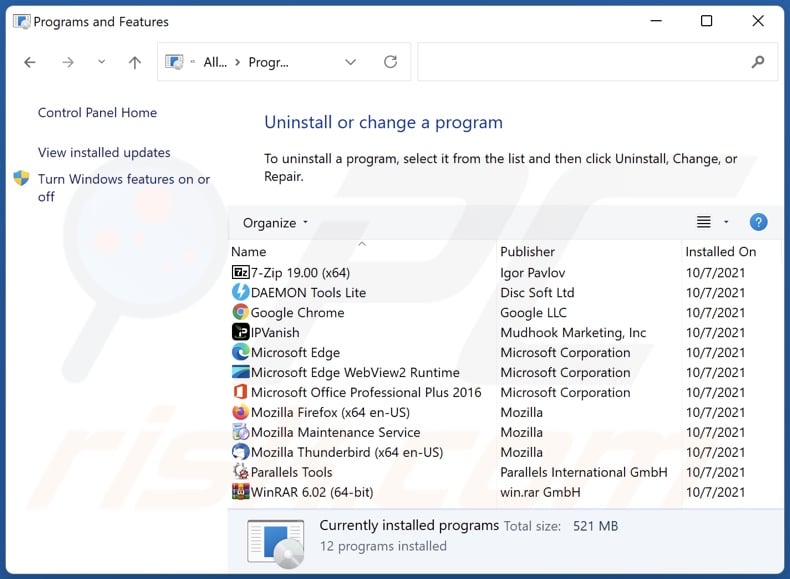
In the uninstall programs window, look for any suspicious applications, select these entries and click "Uninstall" or "Remove".
After uninstalling potentially unwanted applications, scan your computer for any remaining unwanted components or possible malware infections. To scan your computer, use recommended malware removal software.
DOWNLOAD remover for malware infections
Combo Cleaner checks if your computer is infected with malware. To use full-featured product, you have to purchase a license for Combo Cleaner. 7 days free trial available. Combo Cleaner is owned and operated by RCS LT, the parent company of PCRisk.com.
Remove adware from Internet browsers:
At time of research, Words malware did not install any browser plug-ins on Microsoft Edge, Google Chrome, or Mozilla Firefox, however, it was bundled with adware. Therefore, you are advised to remove all potentially unwanted browser add-ons from your Internet browsers.
Video showing how to remove potentially unwanted browser add-ons:
 Remove malicious extensions from Google Chrome:
Remove malicious extensions from Google Chrome:
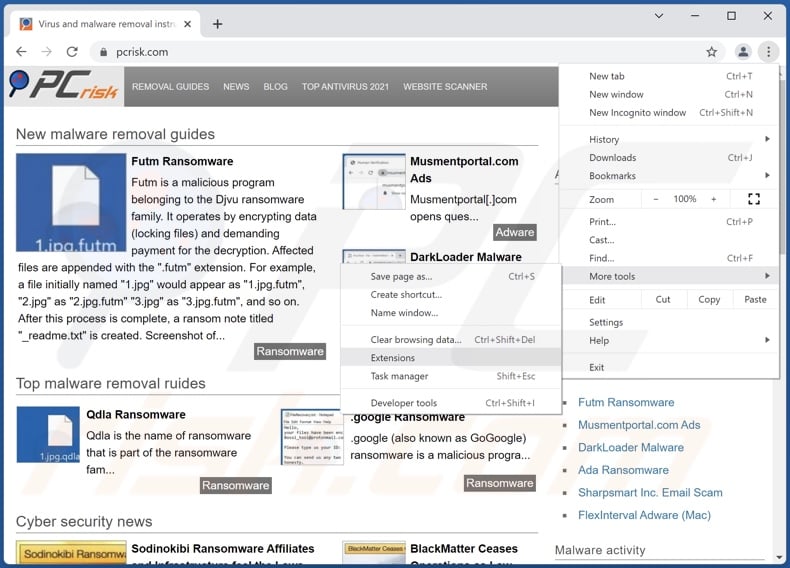
Click the Chrome menu icon ![]() (at the top right corner of Google Chrome), select "More tools" and click "Extensions". Locate all recently-installed suspicious browser add-ons and remove them.
(at the top right corner of Google Chrome), select "More tools" and click "Extensions". Locate all recently-installed suspicious browser add-ons and remove them.
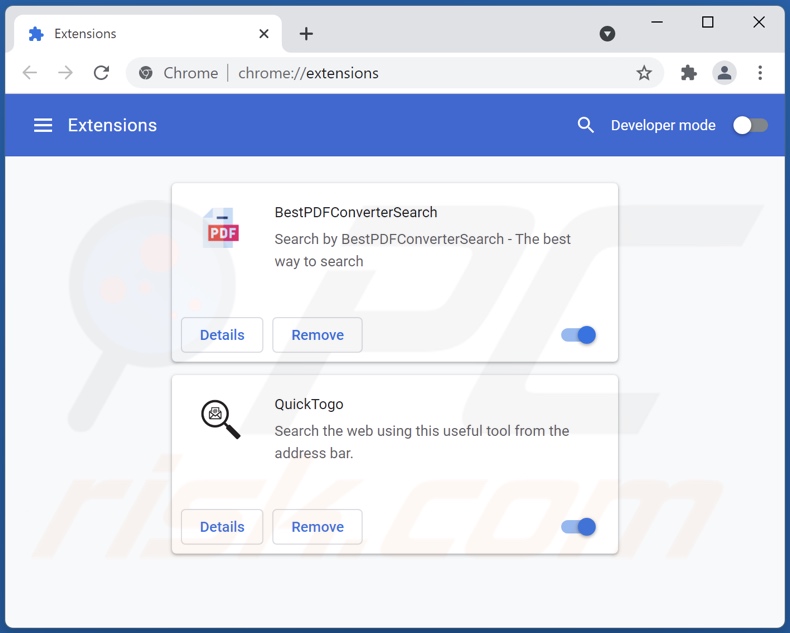
Optional method:
If you continue to have problems with removal of the words virus, reset your Google Chrome browser settings. Click the Chrome menu icon ![]() (at the top right corner of Google Chrome) and select Settings. Scroll down to the bottom of the screen. Click the Advanced… link.
(at the top right corner of Google Chrome) and select Settings. Scroll down to the bottom of the screen. Click the Advanced… link.

After scrolling to the bottom of the screen, click the Reset (Restore settings to their original defaults) button.

In the opened window, confirm that you wish to reset Google Chrome settings to default by clicking the Reset button.

 Remove malicious plugins from Mozilla Firefox:
Remove malicious plugins from Mozilla Firefox:
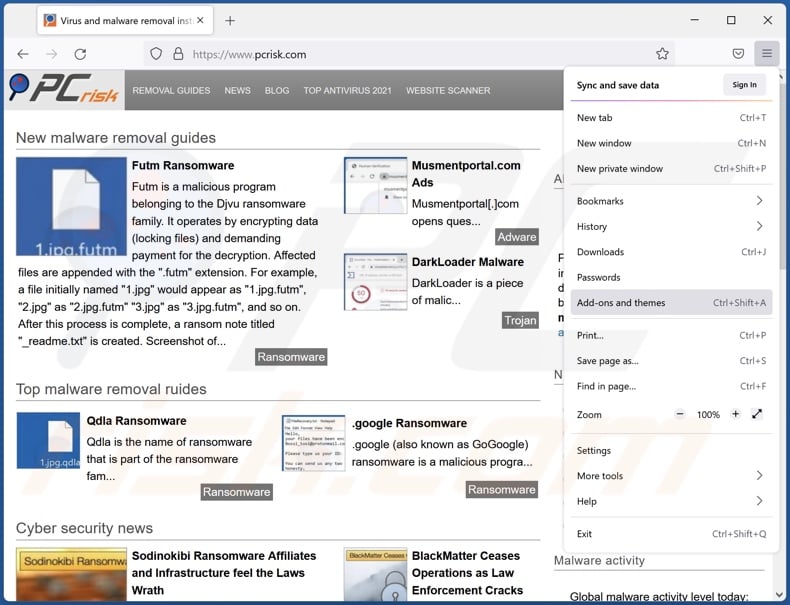
Click the Firefox menu ![]() (at the top right corner of the main window), select "Add-ons". Click on "Extensions", in the opened window remove all recently-installed suspicious browser plug-ins.
(at the top right corner of the main window), select "Add-ons". Click on "Extensions", in the opened window remove all recently-installed suspicious browser plug-ins.
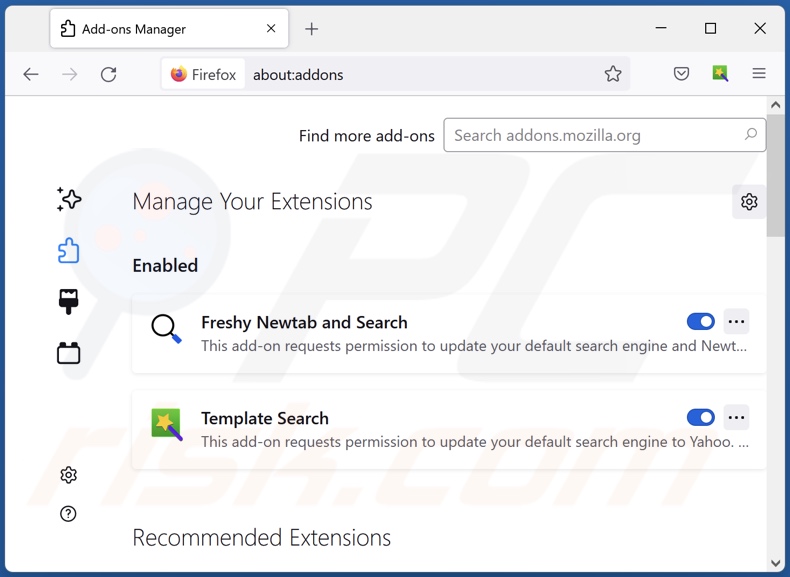
Optional method:
Computer users who have problems with words virus removal can reset their Mozilla Firefox settings.
Open Mozilla Firefox, at the top right corner of the main window, click the Firefox menu, ![]() in the opened menu, click Help.
in the opened menu, click Help.

Select Troubleshooting Information.

In the opened window, click the Refresh Firefox button.

In the opened window, confirm that you wish to reset Mozilla Firefox settings to default by clicking the Refresh Firefox button.

 Remove malicious extensions from Safari:
Remove malicious extensions from Safari:

Make sure your Safari browser is active, click Safari menu, and select Preferences....

In the opened window click Extensions, locate any recently installed suspicious extension, select it and click Uninstall.
Optional method:
Make sure your Safari browser is active and click on Safari menu. From the drop down menu select Clear History and Website Data...

In the opened window select all history and click the Clear History button.

 Remove malicious extensions from Microsoft Edge:
Remove malicious extensions from Microsoft Edge:

Click the Edge menu icon ![]() (at the upper-right corner of Microsoft Edge), select "Extensions". Locate all recently-installed suspicious browser add-ons and click "Remove" below their names.
(at the upper-right corner of Microsoft Edge), select "Extensions". Locate all recently-installed suspicious browser add-ons and click "Remove" below their names.

Optional method:
If you continue to have problems with removal of the words virus, reset your Microsoft Edge browser settings. Click the Edge menu icon ![]() (at the top right corner of Microsoft Edge) and select Settings.
(at the top right corner of Microsoft Edge) and select Settings.

In the opened settings menu select Reset settings.

Select Restore settings to their default values. In the opened window, confirm that you wish to reset Microsoft Edge settings to default by clicking the Reset button.

- If this did not help, follow these alternative instructions explaining how to reset the Microsoft Edge browser.
Frequently Asked Questions (FAQ)
My computer is infected with Words malware, should I format my storage device to get rid of it?
No, Words' removal does not require such drastic measures.
What are the biggest issues that Words malware can cause?
The dangers posed by a malicious program depend on its capabilities and the cyber criminals' modus operandi. Words is designed to force-open deceptive and malicious websites, which can cause severe problems. Generally, malware infections can result in serious privacy issues, financial losses, and identity theft.
What is the purpose of Words malware?
The primary use of malware is to generate revenue for the attackers. However, malicious programs can also be used to amuse the cyber criminals, disrupt processes (e.g., websites, services, companies, organizations, etc.), carry out personal vendettas, and launch politically/geopolitically motivated attacks.
How did Words malware infiltrate my computer?
Words has been notably distributed through fake "cracked" program download websites. The most widely used malware distribution methods include: drive-by downloads, spam emails and messages, online scams, unofficial and freeware download sites, Peer-to-Peer sharing networks, fake updates, and illegal software activation tools ("cracks"). Some malicious programs are also capable of self-spreading through local networks and removable storage devices (e.g., external hard drives, USB flash drives, etc.).
Will Combo Cleaner protect me from malware?
Yes, Combo Cleaner is designed to scan systems and detect as well as eliminate malware infections. It is capable of removing most of the known malicious software infections. However, it has to be stressed that performing a full system scan is essential - since high-end malware typically hides deep within systems.
Share:

Tomas Meskauskas
Expert security researcher, professional malware analyst
I am passionate about computer security and technology. I have an experience of over 10 years working in various companies related to computer technical issue solving and Internet security. I have been working as an author and editor for pcrisk.com since 2010. Follow me on Twitter and LinkedIn to stay informed about the latest online security threats.
PCrisk security portal is brought by a company RCS LT.
Joined forces of security researchers help educate computer users about the latest online security threats. More information about the company RCS LT.
Our malware removal guides are free. However, if you want to support us you can send us a donation.
DonatePCrisk security portal is brought by a company RCS LT.
Joined forces of security researchers help educate computer users about the latest online security threats. More information about the company RCS LT.
Our malware removal guides are free. However, if you want to support us you can send us a donation.
Donate
▼ Show Discussion